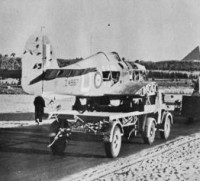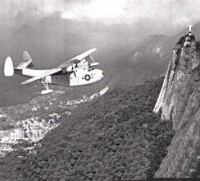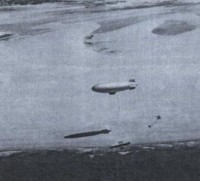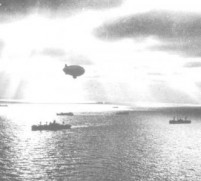- COMMANDER SOUTH ATLANTIC
25)ANTISUBMARINE BLITZ JULY 43
During July, at least 15 submarines operated along the Atlantic Coast of South America. Never before had so many appeared at once, the average for the immediately preceding months having been scarcely a sixth of this number. The Fourth Fleet accepted the challenge, and when the month had ended the score with reference to the submarines read "Sunk, six - probably sunk, two". These kills ranged all the way from the waters near Trinidad to the vicinity of Florianopolis, well south of Rio.
To darken the picture somewhat, the large submarine influx inevitably meant more merchant sinkings. For July the total shipping loss in the Fourth Fleet Area was 14; a loss that, when broken down by nationality, numbered 1 Norwegian, 1 Brazilian, 3 British, and 7 American ships. The tonnage sent to the bottom totalled 89,967. Yet the record could be accounted good. During the first half of 1943, in all areas, United Nations Forces sank three submarines for every ten the latter destroyed. Regardless of whether we accept the figure six or eight as the Fourth Fleet's total for the month, in either case it is well above the average.
The question of why so many submarines appeared off the coast of South America in July is best answered by reference to other areas. Convoys in the North Atlantic were by now so well protected, particularly in the eastern part, that the enemy had to pay a heavy price for the ships he sank. In the Western and Southern Atlantic fewer escorts were available, and more ships had to be routed independently. The Germans would therefore logically reason that here should be easier pickings, with resulting smaller losses to themselves.
The last part of June had foreshadowed increased submarine activity. Several attacks on ships in the Rio area had necessitated the alert between Bahia and Rio, and had occasioned sending additional U. S. Planes to the Brazilian Capital. Furthermore, the convoy terminus had just been changed from Bahia to Rio. Convoys formerly designated BT-TB, now became JT-TJ, as Jig was the letter indicating Rio de Janeiro. These required additional protection, as did a considerable volume of local shipping between Rio and various southern ports, both in Brazil and along the Rio de la Plata. It meant that local convoys often had to be added to the main ones for short parts of the run, as, for instance, ships bound from Rio to Santos of Florianopolis.
NOB Rio faced the task of combining and coordinating Brazilian - U. S. Navy operations for the coastal areas between Carvellas and Florianopolis, a distance of 900 miles. This was the busiest and most important period in the Rio base's history. Two other areas were especially concerned with the submarine menace. One was the bulge of Brazil, meaning roughly the coast lying between Forteleza and Bahia. Finally, the stretch from the Guianas to the Amazon saw several sub actions, three kills, and the sinking of three merchant ships.
To give the story chronologically, the submarines drew the first blood when one of them torpedoed the Brazilian Tutoia off Santos, just before midnight on the last day of June. Seventeen survivors, picked up by a fishing vessel, came ashore the following morning. The next victim was the Elihu Washburne U. S. flag, which a U-Boat sank on July 3, also very close to Santos. In the course of the day Brazilian and American planes twice sighted a sub, very likely the Washburne's attacker, but were unable to do it any damage.
On July 4, the Bury, a small Brazilian merchant vessel, experienced a gunfire attack from a submarine in 23° 2' S, 44° 37' W. This location would put the occurrence very near the Bay of Guanabara (Rio). The Bury, being armed, fired on the sub, and a U. S. plane which observed the shooting gave chase to the enemy. It could make out no sign of the U-Boat; however, Brazilian aircraft and a U. S. Catalina went from Rio to the contact area for a thorough but fruitless submarine hunt. Some time during the previous night, the Navy had suffered the loss of a PBM plane of VP-74. From causes unknown it had crashed in the sea, having no trace save floating wreckage. The accident took place near Rio, all personnel being lost.
The same day, the 4th, in the early afternoon, the Germans scored again, when one of their subs attacked and sank the Pelotasloide, a Brazilian merchant ship. This was far from the Rio area, taking place just below the Equator just off Salinas, near Belem. The Pelotasloide, then bound from Trinidad to Belem, had as her escorts two 110 foot patrol craft, manned by Brazilian crews. She sank in eleven fathoms of water, meaning possibly that a mine and not a torpedo had accounted for her. The two escorts did as much life saving as possible, and turned survivors over to a ship which stood out from Belem to receive them.
Now that the enemy had struck at the northern as well as the southern end of the line, the Commander Fourth Fleet established a Submarine Alert from Belem to Natal. Since one had existed between Bahia and Rio since June 25, and the Brazilian Ministry of Marine had recently declared another from Rio to Santos, this virtually closed the coast of Brazil to independent shipping, except between Natal and Bahia. Next day the Fourth Fleet learned of another casualty. Two whaleboats arrived at Cabedello in Parahyba, not far north of Recife, with 52 survivors of the British Vernon City, torpedoed on June 28 in 04° 20' S, 27° 20' W. News of this loss brought the number of known attacks on merchant ships in the area to eight, and the number of verified sinkings since June to five.
By the end of the first week in July the Fourth Fleet's position looked unenviable. Recent submarine attacks, all the way from French Guiana to Santos, had taxed its anti-submarine units. Convoys formerly terminating at Bahia now had to continue to Rio, adding to the burden. Due to some detachments the previous month, the Fleet was short of Destroyers, only the Somers being available for regular escort work. Six U. S. Navy planes had been transferred through necessity to Rio in support of Brazilian Forces. On paper the Commander of Fleet Air Wing Sixteen had five squadrons available. But mechanical difficulties, routine overhauls, and training periods actually reduced effective strength to about half the normal figure. Meanwhile the submarine crisis grew daily more acute.
The next events seemed to confirm the idea of the Fleet's numerical inadequacy. Very early on the morning of the 7th, a northbound convoy was twice attacked, just above the hump of Brazil. The submarines got three ships, the Sinnickson, Robertson, and Thompson, all U. S. flag. The Hunt, also in the convoy, received a torpedo, but arrived in Trinidad under her own power. The Alcoa Banner and Goiazloide accidentally rammed the torpedoed vessels and received damage, but continued with the convoy. Salvage and repair ships from Natal, Recife, and even Trinidad, came to help with the rescue and to augment the escort. The Fleet Material Officer traveled to the scene in a PC. For several days the search for damaged ships from he convoy went on, until finally the three already named were given up as lost.
Two submarine sightings were reported in the course of the 7th, but neither led to an attack. July 8 brought further bad tidings. A Trinidad-Rio Convoy encountered a sub, and probably more than one, just north of the Amazon' mouth. The B. P. Newton, a Norwegian tanker took fire and went down at once. The Eldena, U. S. flag, received damage which a second torpedo turned into a sinking. This convoy, designated TJ-1, was escorted by the Somers Group, which gained sound contact on two subs, though it was believed that one had done all the firing. The contacts led to attacks, which brought no evidence of any damage to the U-Boats. Following this, the vessels put into Belem.
On July 9 came the first kill of the series, and probably involved one of the submarines that had attacked the convoy the previous day. First a Catalina, belonging to VP-94, sighted a fully surfaced sub in 03° 54' N, 48° 43' W. Lieutenant Hare, the pilot, closed and dropped all his bombs, which fell short. In return came vigorous anti-aircraft fire from the U-Boat which wounded the pilot in the throat so badly that he died a little later. Within five minutes the same plane, with a second pilot at the controls, sighted the wake o another submarine. Being out of bombs it had nothing with which to attack. However, there was another VP-94 Catalina in the neighborhood. This quickly swung into action and destroyed the still surfaced submarine, which left 5 survivors in the water as it sank. The plane dropped them a life raft.
For some time thereafter, planes and surface craft sighted or attacked submarines daily. They did not score another success immediately, however, and in the meantime the U-Boats sank the African Star on the 12th, and the following morning, just after midnight, damaged a Navy B-24 plane. This aircraft, on contacting the enemy, delivered its attack by the use of landing lights, and the effect of its bombs could not be learned. The sub, however, instead of submerging, shot it out with the assailant, which had to return to base on three engines. The position of this action was 05° 22' S, 33° 35' W, not far east of Natal.
Then, for a few days, came a lull. On the 17th, the Admiral lifted the submarine alerts from Belem to Natal and from Bahia to Rio. The reason for this action was not any fancied end of the danger, which nevertheless did seem to have diminished, but the necessity for clearing the harbors of small, coastwise ships which could not be included in convoys.
Things came to life with a vengeance on the 19th. Three encounters between aircraft and subs took place; one resulting in a kill. In the other two cases he submarines more than defended themselves. One damaged an Army B-18, covering a TJ convoy. Two attempts at attack by the pane were driven off by intense anti-aircraft fire. After the U-Boat submerged, depth bombs failed to produce any visible results. This occurred in 04° 40' N, 49° 10' W, not far from the scene of the kill on the 9th.
Close by, but earlier in the day, a Caribbean Sea Frontier plane had attacked a surfaced submarine. Four depth charges seemed to accomplish nothing. The U-Boat remained n the surface and engaged the plane in a machine gun fight, scoring hits on propellers and the tail assembly. The latter had to withdraw, leaving the submarine the mistress of the field. The kill took pace off Florianopolis, far to the south. A VP-74 Mariner, operating from the Tender Barnegat, attacked a surfaced sub. The U-Boat gave back considerable AA fire, but the pilot used effective evasive tactics and straddled the enemy with his bombs. This ended the sub, which sank, leaving a number of survivors in the water. The Barnegat came up as fast as possible and picked up the Germans, including their Captain, Fritz Guggenberger, believed to be the officer who sank the British Carrier Ark Royal.
On July 19, it became known that Convoy TJ-2 was being followed by a submarine. On the 20th, a plane of VP-94 sighted and attacked another 50 miles ahead of the convoy, at 03° 53' N, 48° 45' W. The sub remained on the surface and opened fire immediately. A gun battle went on for approximately an hour. When the plane started away to lead escort surface vessels to the scene, the submarine submerged with apparent difficulty. This was certainly no kill, yet the enemy showed signs of being damaged.
The same sub was very likely the one attacked by another VP-94 plane the following day. The U-Boat sent up anti-aircraft and machine gun fire, but the pilot went straight to his target and made the attack. No doubt could exist regarding his success. The submarine sank immediately, nose up, going down in 03° 56' N, 45° 46' W. Also on the 21st came the report that the Richard Caswell, U. S. flag, had been sunk near Florianopolis on July 16, while proceeding independently from Buenos Aires to Rio. This raised to ten the merchant ship casualty list for the month, if we count the Tutoia, sunk a little before midnight, June 30, and the British Harmonic, which went down on July 15, even though its loss was not yet known.
For the 23rd of July a sure kill and a "probable" can be listed. The certainty occurred earliest in the day, not far from Fernando de Noronha. The morning before, two planes on training sweeps made sightings and an attack, which may have damaged the sub. Others from the same squadron (VB-107) continued with the hold down. A little after daylight on the 23rd, a B-24 sighted and attacked the U-Boat, and apparently crippled it enough to make submergence impossible. Two other planes, on search nearby, flew to the contact, and sank the submarine. The first of these, after straddling the sub with its bombs, plunged into the ocean and was lost with all hands. The U. S. S. Seneca hurried to the scene and picked up two survivors from the U-Boat.
The probable sinking listed for the same day came following a contact made in 07° 10' N, 51° 36' W. The submarine lay fully surfaced when sighted by a VP-94 plane, which flew through stiff anti-aircraft fire to make the attack. The U-Boat nosed up to 30 degrees, rolled to starboard, and disappeared. Some damage, though slight, was sustained by the pane. This took place during dark and rainy weather which made the detection of any possible survivors impossible. However, the main thing that cast doubt on the sub's destruction was an attack delivered slightly later in almost the same spot, by an Army plane operating under the Commander Caribbean Sea Frontier.
For July 24, the only report to come in was that 46 survivors of the British Harmonic had arrived in Bahia. They reported their ship as having been sunk on the 15th by two torpedoes from a German submarine in 23° 00' S, 33° 00' W. Also, on this same day, though the fact was unknown until August, the British Fort Chilcotin, received a torpedo and sank in 15° 03' S, 32° 35' W. Survivors arrived in Rio on the 3rd. Four days then went by without reports of U-Boat activities. But on the 28th survivors of the Henzada reached Montevideo. This ship had been destroyed, as usual by a submarine, on the 24th, not far from Santos. The 29th passed without events of any special importance. Then, on the 30th and 31st, came the events that wound up the month in triumphant fashion.
On the first day, not far from Recife, two enemy submarines were attacked, one being certainly, and both probably, accounted for. The first exploit belonged to a Ventura, one of the lately arrived VP-127 Squadron. The coverage mission for Convoy TJ-2 sighted the sub, fully surfaced, about 25 miles from the convoy rendezvous off Recife. The Ventura arrived in a hurry, on summons, and its bombs straddled the enemy, which sank in four minutes. Numerous survivors were rescued by the Saucy, which hastened to the scene and brought them into Recife. Less than two hours later, another Ventura encountered a submarine about three degrees farther to the south. The plane made its attack, following which there was a reported explosion. The enemy went down, leaving no survivors on the surface. Perhaps no very good reason existed for calling this anything but a sure kill. The caution, however, which the Navy always employs in these cases led to a verdict of "probable".
The last one took place on the 31st, close to Rio, and was a certainty. A Mariner of VP-94 earned the initial credit here by attacking the surfaced sub which fired vigorously on the plane. The Mariner persisted, crippled the enemy, and then remained in the vicinity to draw its AA fire, while a Brazilian Air Force Catalina swooped in to make the actual kill. Therefore, the U. S. Navy and the FAB shared the honors for the final submarine of the month. The fact that on the same day the Brazilian ship Bagé went down north of Bahia, as the result of a torpedo, made the climax a little disappointing. Nevertheless, what had started as an apparent field day for the subs had turned out to be the banner month of the South Atlantic Campaign.
In the course of this July activity, several changes in submarine tactics could be noted. Frequently the enemy U-Boats, when sighted, elected not to dive but to remain surfaced and fight the attackers with their guns, particularly if they lacked time to submerge to a safe depth. A surfaced sub, though dangerous, naturally presented the planes with a better chance to score a kill, and those of Fleet Air Wing Sixteen capitalized on their opportunities. Of the eight U-Boats probably destroyed in July, six were surfaced and firing at the time, while the other two appear to have been surprised before they could submerge. On the whole, the crews of the plane squadrons liked the new tactics and expressed the hope that the subs would continue them.
U-Boats appear to have been fitted with heavier anti-aircraft batteries. They placed their chief reliance in these, and did little firing from their large deck guns. In some cases, the latter seemed to have been removed altogether. In most cases the submarine maneuvered to present its beam to the attackers, for the purpose, apparently, of bringing all its guns most advantageously to bear. While in former months only one submarine customarily patrolled a given area, there were four instances, this time, that seemed to show them working in pairs.
Submarine intelligence regarding convoys seemed all too good. Several of the sinkings occurred at times and places which showed the enemy to be lurking in wait for a merchant ship group. Also, on the average, sighted subs were closer inshore than had bee true of their predecessors. Of the fourteen merchant ships destroyed during the month, six belonged to convoys, while eight proceeded independently. This was in line with old submarine policy in the Fourth Fleet Area; namely to specialize in attacks on unprotected, independently routed ships. The month's activity likewise showed the enemy moving progressively southward, since six of the merchant vessels and two of the subs were destroyed below the parallel of Rio. A few events of interest, other than operational, occurred during the month.
ON the 7th, the Commander Fourth Fleet and the Commanding General U. S. Army Forces (USAFSA) appointed a joint committee consisting of the Chief-of-Staff Fourth Fleet, the Chief-of-Staff USAFSA, and the Chief-of-Staff Army Transport Command (ATC). This committee received executive power to transfer any facilities in the area from one service to the other for use, depending on the shifting needs and the changing situation. There already existed a larger Joint Logistical Committee, which met every two weeks for discussion purposes but which lacked executive authority. The new joint commission of three supplied the power hitherto lacking.
July 25 brought word from the U. S. Naval Attaché in Montevideo that the Uruguayan Government had verbally granted the United States permission to use its territory for sea and land plane operations. This, however, would only be in the event that submarine activity developed off Rio de la Plata. Uruguay's consent formed a reply to a request of this nature, formulated considerably earlier by the Commander Fourth Fleet through the Vice Chief of Naval Operations. On July 12, the Commander Fleet Air Wing Sixteen shifted his administrative command to the Naval Administration Building in Recife. This had previously been located at Natal.
Hyper War. Commander South Atlantic Force. U.S Naval Administration in WW II.



